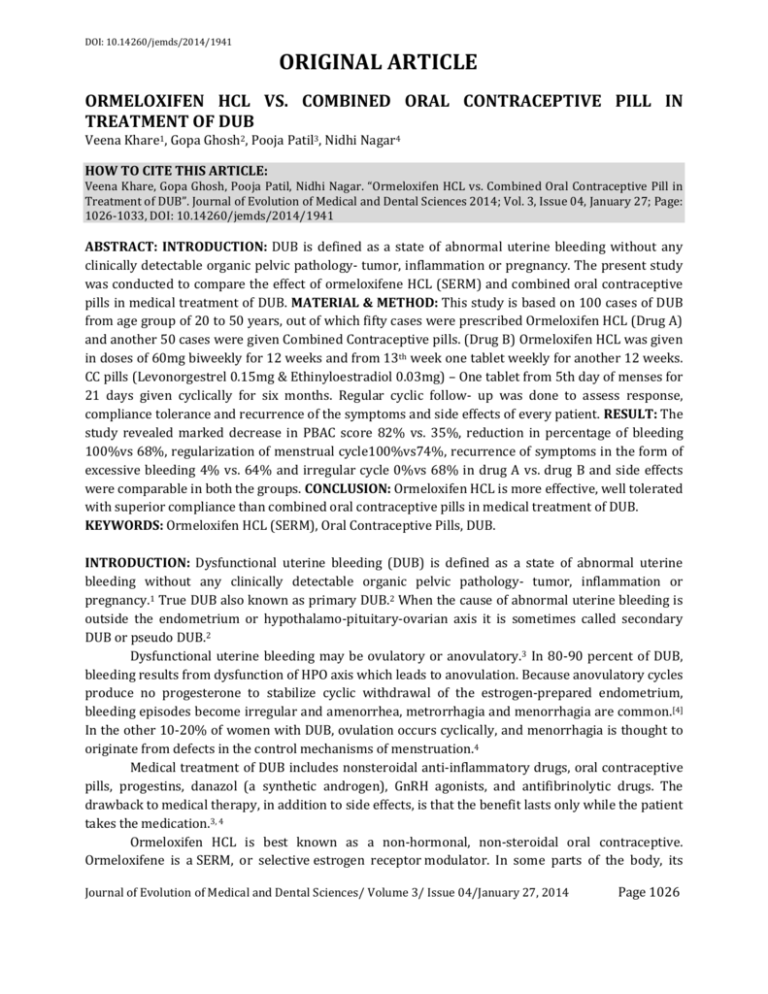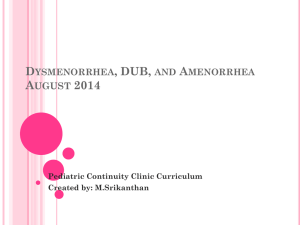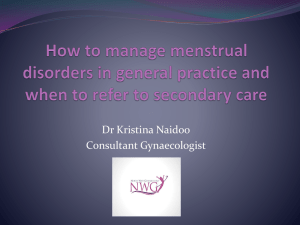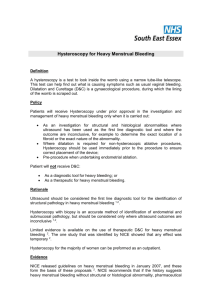ormeloxifen hcl vs. combined oral contraceptive pill in
advertisement

DOI: 10.14260/jemds/2014/1941 ORIGINAL ARTICLE ORMELOXIFEN HCL VS. COMBINED ORAL CONTRACEPTIVE PILL IN TREATMENT OF DUB Veena Khare1, Gopa Ghosh2, Pooja Patil3, Nidhi Nagar4 HOW TO CITE THIS ARTICLE: Veena Khare, Gopa Ghosh, Pooja Patil, Nidhi Nagar. “Ormeloxifen HCL vs. Combined Oral Contraceptive Pill in Treatment of DUB”. Journal of Evolution of Medical and Dental Sciences 2014; Vol. 3, Issue 04, January 27; Page: 1026-1033, DOI: 10.14260/jemds/2014/1941 ABSTRACT: INTRODUCTION: DUB is defined as a state of abnormal uterine bleeding without any clinically detectable organic pelvic pathology- tumor, inflammation or pregnancy. The present study was conducted to compare the effect of ormeloxifene HCL (SERM) and combined oral contraceptive pills in medical treatment of DUB. MATERIAL & METHOD: This study is based on 100 cases of DUB from age group of 20 to 50 years, out of which fifty cases were prescribed Ormeloxifen HCL (Drug A) and another 50 cases were given Combined Contraceptive pills. (Drug B) Ormeloxifen HCL was given in doses of 60mg biweekly for 12 weeks and from 13th week one tablet weekly for another 12 weeks. CC pills (Levonorgestrel 0.15mg & Ethinyloestradiol 0.03mg) – One tablet from 5th day of menses for 21 days given cyclically for six months. Regular cyclic follow- up was done to assess response, compliance tolerance and recurrence of the symptoms and side effects of every patient. RESULT: The study revealed marked decrease in PBAC score 82% vs. 35%, reduction in percentage of bleeding 100%vs 68%, regularization of menstrual cycle100%vs74%, recurrence of symptoms in the form of excessive bleeding 4% vs. 64% and irregular cycle 0%vs 68% in drug A vs. drug B and side effects were comparable in both the groups. CONCLUSION: Ormeloxifen HCL is more effective, well tolerated with superior compliance than combined oral contraceptive pills in medical treatment of DUB. KEYWORDS: Ormeloxifen HCL (SERM), Oral Contraceptive Pills, DUB. INTRODUCTION: Dysfunctional uterine bleeding (DUB) is defined as a state of abnormal uterine bleeding without any clinically detectable organic pelvic pathology- tumor, inflammation or pregnancy.1 True DUB also known as primary DUB.2 When the cause of abnormal uterine bleeding is outside the endometrium or hypothalamo-pituitary-ovarian axis it is sometimes called secondary DUB or pseudo DUB.2 Dysfunctional uterine bleeding may be ovulatory or anovulatory.3 In 80-90 percent of DUB, bleeding results from dysfunction of HPO axis which leads to anovulation. Because anovulatory cycles produce no progesterone to stabilize cyclic withdrawal of the estrogen-prepared endometrium, bleeding episodes become irregular and amenorrhea, metrorrhagia and menorrhagia are common.[4] In the other 10-20% of women with DUB, ovulation occurs cyclically, and menorrhagia is thought to originate from defects in the control mechanisms of menstruation.4 Medical treatment of DUB includes nonsteroidal anti-inflammatory drugs, oral contraceptive pills, progestins, danazol (a synthetic androgen), GnRH agonists, and antifibrinolytic drugs. The drawback to medical therapy, in addition to side effects, is that the benefit lasts only while the patient takes the medication.3, 4 Ormeloxifen HCL is best known as a non-hormonal, non-steroidal oral contraceptive. Ormeloxifene is a SERM, or selective estrogen receptor modulator. In some parts of the body, its Journal of Evolution of Medical and Dental Sciences/ Volume 3/ Issue 04/January 27, 2014 Page 1026 DOI: 10.14260/jemds/2014/1941 ORIGINAL ARTICLE action is estrogenic (e.g., bones), in other parts of the body, its action is anti-estrogenic (e.g., uterus, breasts.5, 6 It causes an asynchrony in the menstrual cycle between ovulation and the development of the uterine lining, although its exact mode of action is not well defined. In clinical trials, it caused ovulation to occur later than it normally would in some women, 7 but did not affect ovulation in the majority of women, while causing the lining of the uterus to build more slowly. It is contraindicated in patients with polycystic ovarian disease, recent history of jaundice, liver impairment, and kidney impairment, abnormal growth of cervix, pregnancy, lactation and hypersensitivity.5, 6 Ormeloxifene is only legally available in India as of 2009.8 Oral contraceptive pills (OCPs) suppress endometrial development, reestablish predictable bleeding patterns, decrease menstrual flow, and lower the risk of iron deficiency anemia. There presumed method of action is endometrial atrophy. There may also be diminished prostaglandin synthesis & decreased endometrial fibrinolysis.9 OCPs are absolutely contraindicated in hypertension (systolic > 160mmHg or diastolic > 100mmHg), current or past history of venous thromboembolism (VTE), ischemic heart disease, history of cerebrovascular accident, complicated valvular heart disease (pulmonary hypertension, atrial fibrillation, history of sub acute bacterial endocarditis), migraine headache with focal neurological symptoms, breast cancer (current), diabetes with retinopathy/nephropathy/neuropathy, severe cirrhosis, liver tumor (adenoma or hepatoma). MATERIAL AND METHOD: This prospective comparative study was done in OPD of L. N. Medical College & J. K. Hospital from January 2011 to 2013.Proper history was taken from patients coming to OPD with complaints of menorrhagia and systemic and per speculum and per vaginal examination was done, pap smear was taken and ultrasound was done to rule out any organic pathology in the uterus. Inclusion criteria: All patients with DUB of 20-50 years of age were included in the study. Exclusion criteria: Patients who were pregnant, lactating, with history of heart disease, hypertension, migraine, Polycystic ovarian disease, liver and kidney impairment were excluded. Informed consent was taken from patients. Patients were divided into two groups of 50 patients: Group ‘A’ Ormeloxifene HCL (SERM) and Group ‘B’ CC Pills Group A – Ormeloxifene was given in doses of 60mg tablet biweekly for 12 weeks and from th 13 week 60mg tablet weekly for another 12 weeks. Group B – CC Pills – one tablet containing levonorgestrel 0.15 mg and ethinylestradiol (.03mg) from 5th day of menses for 21 days given cyclically for six months. Follow up for six months on every cycle was done to assess the symptoms in the form of amount of bleeding(which was assessed by PBAC score), backache, dysmenorrhea and regularization of menstrual cycles and also assessed the recurrence of symptoms after completion of treatment and the side effects of each drug. Results were evaluated by Mean, Standard deviation and statistical significance was derived by ‘p’value calculated by Z technique. Journal of Evolution of Medical and Dental Sciences/ Volume 3/ Issue 04/January 27, 2014 Page 1027 DOI: 10.14260/jemds/2014/1941 ORIGINAL ARTICLE OBSERVATIONS & RESULTS: No. of patient in No. of patient Group ‘A’ in Group ‘B’ S.No. Age Group 1 2 3 20 – 30 years 31 – 40 years 41 – 50 years Total no. of patient 18 16 16 50 18 16 16 50 Total no. of patients 18 +18 = 36 16 + 16 = 32 16 + 16 = 32 100 Table No. 1: Age wise distribution of patients Ormeloxifen HCL(A) 49 (81.67%) Mild Marked CC Pills(B) 8(13.33%) 21(35%) Table No. 2: Improvement in PBAC (Pictorial bleeding assessment criteria) score in both groups Marked improvement by PBAC noted in group A. Variable PBAC → Before treatment PBAC → After treatment No. of Patient Minimum Maximum Mean Standard deviation 50 16.0 142.0 108.70 30.44 50 0 119.0 63.58 28.91 Table No. 3: PBAC score in Ormeloxifene HCL (Group A) Variable PBAC → Before treatment PBAC → After treatment No. of Patients Minimum Maximum Mean Standard Deviation 50 14 142 113.87 25.74 50 16 132 94.00 26 Table No. 4: PBAC score in Combined Oral Contraceptive Pills (Group B) PBAC SCORE decreased more in Group A than in Group B after treatment. Journal of Evolution of Medical and Dental Sciences/ Volume 3/ Issue 04/January 27, 2014 Page 1028 DOI: 10.14260/jemds/2014/1941 ORIGINAL ARTICLE Age & No. of patient S.No. Decrease in amount of Bleeding N No. of patient I 1 2 I 2 18 0 36% 2 31– 40years/16 16 0 32% 16 0 32% 50 0 100% 1 1 0 0 1 Total-50 I 0 0 16 0 0 5 18 0 3 3 0 NI I 0 0 36% 1 0 0 32% 1 0 24% 1 4 4 0 92% 4 3 12 46 1 Regularization of menstrual cycle N No. % of patient Dysmenorrhea N No.% of patient NI 1 20-30years/18 41– 3 50years/16 3 NI Backache N No. %of patient NI 0 0 I 0 0 NI 16 3 8 0 8% 8% 3 4 2 0 8 2 12 36 I 0 32% 16% 0 4 9 NI 1 0 0 16% 1 16 0 0 8% 2 16 0 1 28% 7 50 0 1 24% 14 8 72% 3 NI 3 18 4% 0 I 0 I 0 0 00 1 0 0 3 0 1 0 0 3 0 32% 4 100% 0 0 1 0 32% 0 2 NI 1 36% 1 % Table No.5 Treatment Outcome in Group A I – improvement, N – no improvement Amount of bleeding → p value = p<.05 significant Backache → p value = p<.05 significant Dysmenorrhea →p value = p<.05 significant Effect on menstrual cycles →p value = p<.05 statistically significant p value calculated by Z technique S.N. o Age & No. of patient Amount of Bleeding No. of patient I NI I 2 1 2 8 2 1 –40 years/1 6 2 10 3 1 –50 years/1 6 3 16 0 32% 34 16 68% Total-50 16% 3 6 No. of patient % 20 –30 years/1 8 10 Backache 20% 4 NI I 0 1 20% 4 1 0 12% 2 16 1 3 0 0 1 32% 4 3 6 24 14 0 12 26 No. of patient % NI 1 Dysmenorrhea I 2 1 0 3 8% 32% 8% 48% 0 1 NI I NI 1 28% 0 12 6 0 3 12 4 0 0 1 24% 9 0 2 2 52% 4 33 7 17 Effect on menstrual cycle No. of patient % I 2 0 2 5 24% 24% 18% 66% 1 1 NI I NI 0 12% 2 14 4 0 2 14 4 8% 0 0 14% 9 1 3 1 34% 6 35 7 15 % I 1 0 1 3 28% 28% 18% 70% NI 1 1 0 8% 0 2 0 0 0 14% 1 1 3 1 30% 7 3 8% Table No. 6: Treatment Outcome in Group B Journal of Evolution of Medical and Dental Sciences/ Volume 3/ Issue 04/January 27, 2014 0 Page 1029 DOI: 10.14260/jemds/2014/1941 ORIGINAL ARTICLE I – improvement, N – No improvement Amount of bleeding → p value = p>.05 insignificant Backache → p value = p>.05 insignificant Dysmenorrhea →p value = p>.05 insignificant Effect on menstrual cycles →p value = p>.05 insignificant In group A there was significant decrease in bleeding and regulation of menstrual cycle as compared to group B. The symptomatic improvement in other symptoms like backache, dysmenorrhea is comparable in both the groups. S.No. Age & No. of patient Increase in amount of Bleeding Backache No. of patient NR 1 20 –30 years/18 2 1 –40 years/16 3 1 –50 years/16 R No. of % patient NR 2 1 18 0 36% 3 2 16 0 32% 4 3 Total-50 14 2 28% 48 2 96% R 1 0 1 1 4 0 4% 4% NR 0 0 0 2 14 13 16 43 3 3 2 9 Irregularisation of menstrual cycle Dysmenorrhea No. of % patient R NR R 4 0 28% 1 3 0 26% 1 0 0 32% 1 7 4 86% 4 8% 6% 0 14% No. of % patient NR R 0 2 12 6 0 2 16 0 0 3 16 0 7 8 44 6 NR 0 0 0 1 24% 32% 32% 88% R 1 1 1 4 12% 0 0 12% NR R 0 2 18 0 0 3 16 0 0 3 16 0 6 8 50 0 % NR R 1 36% 1 0 1 0 1 32% 32% 100% 1 5 0 0 0 0 0 0 3 0 3 0 1 Table No. 7: Recurrence of symptoms in Group A NR-No Recurrence R-Recurrence Recurrence of symptoms Group “A” Increase in amount of bleeding → p value = p<.05 Backache → p value = p >.05 insignificant Dysmenorrhea →p value = p>.05 insignificant Irregularisation of menstrual cycles →p value = p<.05 significant Table No. 8 Recurrence of symptoms in Group B Age & No. of patient Increase in amount of Bleeding Backache Irregularisation of menstrual cycle Dysmenorrhea S.No. No. of patient NR R No. of % patient NR R NR R No. of % patient NR R NR R No. of % patient NR R Journal of Evolution of Medical and Dental Sciences/ Volume 3/ Issue 04/January 27, 2014 NR % R NR Page 1030 R DOI: 10.14260/jemds/2014/1941 ORIGINAL ARTICLE 1 20 –30 years/18 2 1 –40 years/16 3 1 –50 years/16 Total-50 1 2 6 12 12% 10 12% 7 9 14% 19 31 38% 3 2 6 T 0 4 3 0 0 1 1 24% 1 18 0 1 20% 1 11 5 9 18% 1 0 16 3 62% 3 29 21 2 36% 2 1 1 22% 1 0 0 6 58% 2 3 17 1 0 10% 2 16 0 1 32% 0 14 2 2 42% 5 47 3 0 0 0 34% 1 1 1 32% 3 0 17 0 1 20% 1 0 1 14% 0 3 1 34% 6 18% 6 66% NR-No Recurrence R-Recurrence Recurrence of symptoms in Group “B” Increase in amount of bleeding → in all age group – p value = p>.05 insignificant Backache → p value = p >.05 insignificant Dysmenorrhea →p value = p>.05 insignificant Irregularisation of menstrual cycles →p value = p>.05 insignificant Side effects Ormeloxifene HCL CC pills Nausea & vomiting 4 Weight gain 3 Headache 1 5 Oligomenorrhoea 8 Menopause 4 Table No. 9: Side effects DISCUSSION: - DUB is the problem from which about 55% females suffer during their reproductive age, during menarche, after delivery or in premenopausal age. Kriplani et al10 analysis of PBAC score in 60 patients, 42% cases revealed decrease in score at 2nd & 4th month of treatment respectively P value (P< 0.001) thus percentage of reduction was 97% at fourth month. In our study in Group A patients, 81.67% showed marked improvement in PBAC score and in Group B patients 35% showed marked improvement in PBAC score which shows that Ormeloxifene is a better drug in reducing the amount of menstrual bleeding. In the study by Neha et al7 the reduction in mean PBAC score with ormeloxifene (216 to 88) was significantly more than with norethisterone (262 to 162) at 3 months (p<0.01).In our study reduction in mean PBAC group in the Ormeloxifene group was from 109 to 64 and in the CC Pills group was from 114 to 94 after completion of 6 months of treatment which shows that significant decrease in PBAC score in the Ormeloxifene group compared to Combined Contraceptive pills. Evidence suggests that hormonal contraceptives are effective in the treatment of DUB and when used long term, reduce flow by 40 to 70 percent11, 12 In Kriplani et al 10 study seven patients (16.7%) had no response and three (7.1%) discontinued the treatment before 4 month. In our study, all patients in Group A responded to the Journal of Evolution of Medical and Dental Sciences/ Volume 3/ Issue 04/January 27, 2014 0 00 12% 7 9 1 36% 0 2 33 0 10 9 3 0 0 0 6% 3 6 4% 4 18 0 1 94% 0 0 28% 4 2% Page 1031 DOI: 10.14260/jemds/2014/1941 ORIGINAL ARTICLE drug whereas 16 out of 50 patients in Group B did not show any response in decrease in menstrual bleeding. Dadhichi et al13 also concluded that SERM is a better choice in management of DUB than norethindrone. Here in our study comparison between SERM and CC Pills was noted in all age groups of patients, reduction in bleeding was found to be statistically significant, P value (P<.05) with drug A than drug B. Improvement in dysmenorrhea and backache with drug A was statistically significant (P<.05) than ‘B’ group. Especially in patients of 41 to 50 years age group, drug A had significant improvement in flow of bleeding. Nelson AL 14, Irvine GA, Camron et al9 observed that SERM is better choice in all the aspects for the treatment of menorrhagia / DUB. But it was not clear that whether this drug (SERM) was found to be a better choice in comparison to the CC Pills. In our study also in all age groups of the patients bleeding found to be satisfactorily decreased and statistically significant (P<.05) with drug A than with drug B, decrease in intensity of the backache is also significant (P<.05) than group B. In the Ormeloxifene group, four patients attained menopause after completion of six months treatment, eight patients had oligomenorrhoea and rest of the patients had regular normal cycles. After six months of treatment there was almost no recurrence of symptoms noted in any patient with drug A whereas in group B 62% patients had recurrence of increased menstrual bleeding after completion of treatment for six months. Also there was recurrence of backache in 42% and irregularisation of menstrual cycles in 34% of patients who received CC pills. Dysmennorhoea though was relieved in 96% of patients without recurrence. The side effects were minimal in both the groups. Nausea, headache and weight gain was seen in few patients of CC pills and oligomenorrhoea and menopause was present in the Ormeloxifene group of patients. CONCLUSION: Ormeloxifene(SERM) is more effective well tolerated, with better compliance and shows long term recurrence free interval in treatment of dysfunctional uterine bleeding than CC Pills. REFERENCES: 1. D. C. Dutta. Abnormal menstrual bleeding. Textbook of gynecology: 4th edn; p177. 2. Haresh U. Doshi, Alka Kriplani. Clinical cases in Obstetrics & Gynecology, first edition, p250-251, 2003. 3. V. L. Bhargava. Textbook of Gynaecology 2nd edition 2009;p109 4. John O. Schorge, Joseph I. Schaffer et al. Williams Gynecology, Abnormal uterine bleeding; p186. 5. Gara Rishi Kumar, Konwar Rituraj, Bid Hemant K and MM Singh. In-vitro anti-cancer breast activity of ormeloxifene is mediated via induction of apoptosis and autophagy. 37th annual conference of the endocrine society of India. 30 nov-2 Dec, 2007; Abstract p35. 6. Nigam, Manisha; Ranjan, Vishal; Srivastava, Swasti; Sharma, Ramesh; Balapure, Anil K. "Centchroman induces G0/G1 arrest and Caspase-dependent Apoptosis involving Mitochondrial Membrane Depolarization in MCF-7 and MDA MB-231 Human Breast Cancer Cells". Life Sciences, 2008; 82 (11–12); 577–90. Journal of Evolution of Medical and Dental Sciences/ Volume 3/ Issue 04/January 27, 2014 Page 1032 DOI: 10.14260/jemds/2014/1941 ORIGINAL ARTICLE 7. Neha Agarwal, Saroj Singh, Shikha Singh, Mohit Agarwal, R. Minoche Dadhichi S. Agarwal S. Soni.M, Jain.R. Role of SERM in medical management of DUB. Asian Obst and Gynecol. Practice 2012; 6; 2831. 8. Patil, Robin D. Tribhuwan & Benazir D. (2009). Body image: human reproduction and birth control: a tribal perspective. New Delhi: Discovery Pub. House. p. 20. 9. Irvine GA, Cameron IT. Medical management of Dysfunctional uterine bleeding. Best Pract Res Clin Obstet Gynaecol.1999; 13(2):189 10. Kriplani A, Kulshreshtha V, Agarwal N. Efficacy and safety of ormiloxefene hcl in management of menorrhagia, A pilot study. J Obst and Gynecol, August 2009; rest 35(4) 7463201:10 1111/ 14470756. 11. Agarwal N, Kriplani A. Medical management of DUB. Int J Gynecol Obstet 75.199:2001 12. Fraser IS, McCarron G. Randomized trial of 2 hormonal and 2 prostaglandin-inhibiting agents in women with a complaint of menorrhagia. Aust N Z J Obstet Gynecol 31:66;1991. 13. Dadhichi S. Agarwal S. Soni M, Jain R. Role of SERM in medical management of DUB. Asian obst and gynecol. Practice 2012:6;2831. 14. Nelson A.L, Teal S.B. Medical therapies for chronic menorrhagia. Obst and Gynecol Sur. 2007;62(4);272- 81. AUTHORS: 1. Veena Khare 2. Gopa Ghosh 3. Pooja Patil 4. Nidhi Nagar PARTICULARS OF CONTRIBUTORS: 1. Assistant Professor Department of Obstetrics and Gynaecology, J.K. Hospital, L.N. Medical College, Bhopal. 2. Consultant, Department of Oncology, J.K. Hospital, L.N. Medical College, Bhopal. 3. Assistant Professor Department of Obstetrics and Gynaecology, J.K. Hospital, L.N. Medical College, Bhopal. 4. Assistant Professor Department of Obstetrics and Gynaecology, J.K. Hospital, L.N. Medical College, Bhopal. NAME ADDRESS EMAIL ID OF THE CORRESPONDING AUTHOR: Dr. Veena Khare, Plat # 11, Sarvadharam, C-Sector, Kolar Road, Bhopal. E-mail: drveenakhare@gmail.com Date of Submission: 08/01/2014. Date of Peer Review: 09/01/2014. Date of Acceptance: 16/01/2014. Date of Publishing: 25/01/2014. Journal of Evolution of Medical and Dental Sciences/ Volume 3/ Issue 04/January 27, 2014 Page 1033









